You’re seeing tangible progress: narrowband radio candidates are now screened with precise spectral and timing analyses, while nanosecond optical pulse searches use fast detectors and coincidence logic to cut false positives. Multiwavelength follow-up, archival reanalysis, and AI-driven classifiers sharpen candidate selection. Infrared surveys hunt waste-heat and atmospheric spectra look for industrial gases, and lab simulations test detectability and protocols. International verification frameworks are maturing — keep going and you’ll find detailed methods, examples, and implications.
Key Takeaways
- Detection methods improved: advanced radio and optical instruments now identify narrowband signals and nanosecond laser pulses with higher sensitivity.
- AI-driven classification: machine learning automates signal vetting, reduces false positives, and prioritizes credible technosignature candidates.
- Multiwavelength follow-up: rapid coordinated observations across radio, optical, and infrared constrain origins and physical environments.
- Novel technosignatures: searches target waste-heat infrared excesses and industrial atmospheric pollutants as indirect evidence of technology.
- Archival reanalysis and anomaly detection: modern algorithms recover faint, previously missed signals and rigorously classify anomalous transit or burst events.
Breakthrough Radio Signals and Narrowband Detections
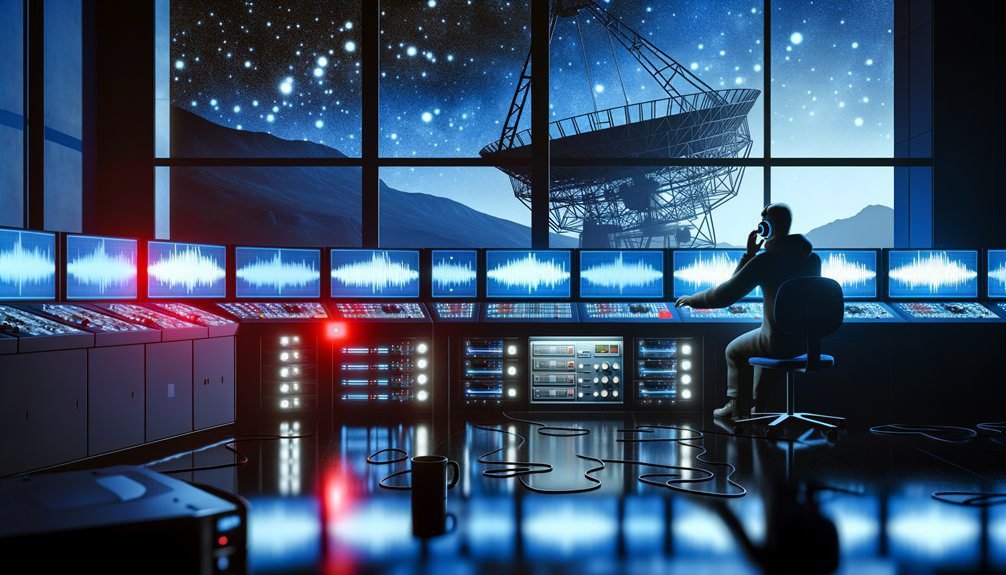
When you examine breakthrough radio signals and narrowband detections, the key question is whether their spectral and temporal characteristics can reliably distinguish technosignatures from natural or instrumental phenomena. You’ll assess narrowband features against expected astrophysical line shapes and look for modulation patterns inconsistent with known sources. Precise timing analysis and frequency drift tracking let you separate Doppler effects from engineered stability. You’ll apply rigorous cosmic noise filtering to reduce false positives, modeling background statistics and antenna response. Cross-validation with independent observatories and archival data strengthens claims, while machine-learning classifiers highlight anomalous events for human review. You should remain open to exotic signal origins but demand reproducibility and multi-channel confirmation. Your protocols must document detection thresholds, calibration steps, and mitigation of radio-frequency interference. By insisting on quantitative metrics — signal-to-noise ratios, persistence, and polarization behavior — you’ll convert intriguing detections into credible candidates or clear non-detections, advancing search reliability.
Optical SETI: Advances in Laser Pulse Searches
Although radio searches remain central, optical SETI has matured into a complementary frontier by exploiting advances in fast photodetectors, timing, and signal processing to hunt for nanosecond-scale laser pulses that would stand out against astrophysical backgrounds. You’ll want to know how recent improvements change your search strategy: higher-bandwidth detectors and real-time coincidence logic reduce false positives, while adaptive optics and narrow-field surveys concentrate sensitivity on candidate stars. Laser communication advancements mean potential transmitters could use predictable, high-peak-power pulses that are easier to discriminate than broadband noise. Your analysis benefits from cross-validation methods—simultaneous multi-site observations and spectral filtering—that strengthen claims of extraterrestrial signal detection without relying on single-instrument anomalies. You’ll also consider detection thresholds, duty cycles, and search completeness to quantify non-detections. Practically, integrating optical pulse searches with radio campaigns optimizes resource allocation and increases the chance of catching engineered signals whose characteristics you can model and test with existing laboratory and astronomical techniques.
Discoveries From Fast Radio Burst Observations
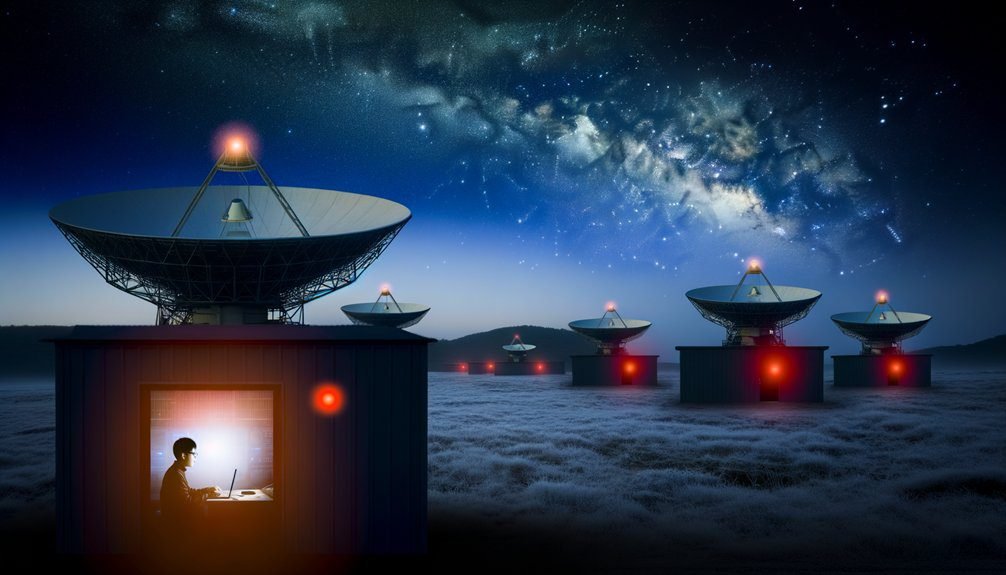
You should scrutinize FRB signal patterns for non-random structure that could distinguish natural processes from engineered transmission. Pay special attention to repeating burst sources, since their recurrence lets you test hypotheses about periodicity, modulation, and source environments. Coordinate rapid multiwavelength follow-up to constrain energetics and local conditions that might clarify whether any anomalies merit targeted SETI investigation.
FRB Signal Patterns
Because FRB signal patterns display a surprising variety of time-frequency structures, you’ll want to approach them with both statistical rigor and an eye for outliers: narrowband sweeps, complex sub-pulse drift, repeating versus one-off morphologies, and polarization changes each encode different propagation and source physics. You’ll parse dynamic spectra, quantify dispersion measures, and separate intrinsic features from propagation effects. For clear signal interpretation, apply Bayesian model selection and time-resolved polarization analysis to distinguish source signatures from cosmic noise and instrumental artifacts. Look for consistent modulation indices, frequency-dependent arrival times, and correlated polarization swings. By treating patterns as hypothesis-driven datasets rather than curiosities, you’ll extract constraints on emission mechanisms, magnetic environments, and intervening plasma with measured confidence.
Repeating Burst Sources
When you examine repeating fast radio burst (FRB) sources, you’ll find a distinct class of emitters that reshape how we infer progenitors and local environments: unlike one-off events, repeaters exhibit varied repeater rates, burst morphologies, and activity windows that let us test models against temporally resolved populations rather than single-shot statistics. You can use repeaters to probe how signal patterns evolve, isolating sub-burst structure, polarization, and frequency drift to constrain emission mechanisms. By comparing repeater demographics and host properties you’ll assess links to young magnetars, compact-object interactions, or exotic scenarios, grounding hypotheses in observable distributions. Repeating behavior also informs searches for periodicity and environmental modulation, narrowing plausible cosmic origins while guiding targeted monitoring strategies.
Multiwavelength Follow-Up
Repeating FRB sources have given us finely time-resolved clues about progenitors and environments, and following those radio detections across the electromagnetic spectrum has multiplied the diagnostic power. You’ll find that coordinated multiwavelength observations — from X-ray to optical and radio interferometry — let you isolate contemporaneous counterparts, constrain energetic budgets, and test emission models. By comparing light curves, spectra, and polarization you refine signal interpretation: is the burst magnetically powered, shock-driven, or influenced by a local nebula? Rapid-response campaigns narrow localization, reveal persistent sources, and measure dispersion and scattering in situ. You’ll use statistical association and physical modeling to separate chance alignment from causal connection, improving confidence in claims about origins and environmental conditions around repeating FRB sources.
Technosignature Surveys Beyond Radio Astronomy
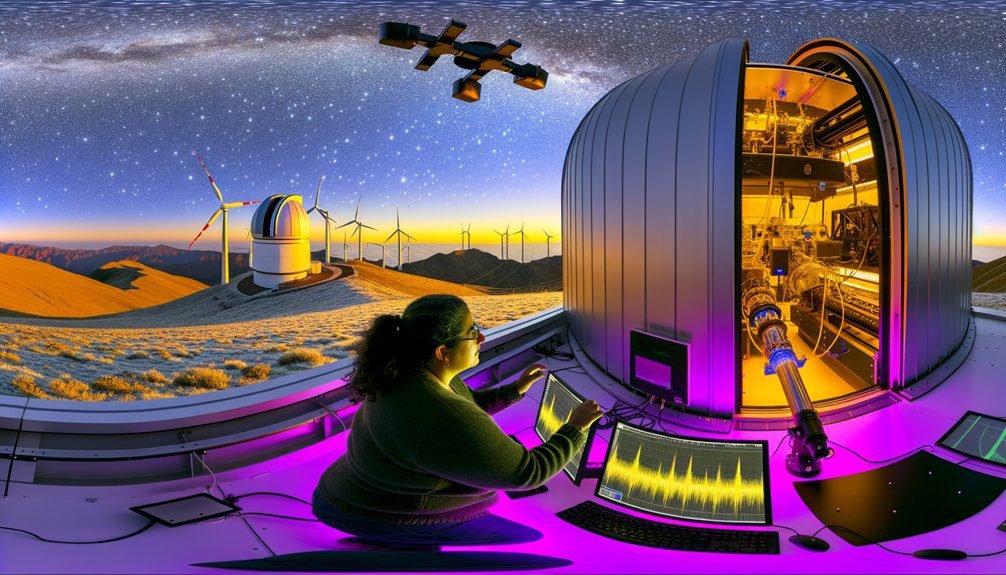
You should consider expanding searches beyond radio to include targeted optical laser surveys, which can reveal pulsed or continuous coherent light signals with precise temporal signatures. You’ll want to assess infrared waste heat as a broad, energy-based technosignature that could indicate large-scale engineering even when emissions are thermally reprocessed. Finally, compare atmospheric spectra for industrial pollutants that would stand out from natural chemistry as compelling evidence of technological activity.
Optical Laser Searches
Because lasers concentrate enormous power into narrow beams and very brief pulses, optical searches offer a complementary path to radio SETI for detecting engineered signals across interstellar distances. You’ll examine how laser communication techniques could produce detectable, non-thermal flashes or continuous-wave beacons distinct from astrophysical sources. You’ll evaluate modulation schemes, timing, and spectral signatures against noise, atmospheric effects, and detector limits, keeping extraterrestrial signaling protocols in mind to prioritize search strategies.
- Targeted vs. all-sky surveys: trade-offs in sensitivity and sky coverage
- Pulse detection: timing resolution, false positives, and coincidence arrays
- Spectral analysis: narrowband lasers, Doppler shifts, and dispersion corrections
You’ll use quantitative thresholds and testable hypotheses to guide observations and instrument design.
Infrared Waste Heat
Optical searches for concentrated, engineered light tell you about intentional signaling, but they won’t reveal the byproducts of large-scale energy use that an advanced society can’t or won’t beam toward us. You’d instead look for excess infrared emissions as a redistribution of harvested energy: waste heat radiated at mid- to far-infrared wavelengths. By modeling expected stellar and planetary spectra, you can quantify deviations and identify thermal anomalies inconsistent with natural processes. Instrument sensitivity, spatial resolution, and careful subtraction of dust and star-formation signatures are essential to avoid false positives. The approach gives you a way to detect large-scale engineering regardless of intent, by constraining energy budgets and characteristic temperatures. It’s a complementary, physics-grounded technosignature pathway.
Atmospheric Pollutants
Pollutant gases in an exoplanet’s atmosphere can serve as indirect fingerprints of technology when their abundances, chemical combinations, or vertical distributions defy plausible natural production and loss processes. You’d use atmospheric monitoring to distinguish anomalous species or ratios that suggest industrial activity rather than volcanic or biological origins. You’d evaluate persistence, photochemical lifetimes, and transport to rule out false positives.
- Look for molecules like chlorofluorocarbons or odd halogenated compounds unlikely from known pollution sources.
- Compare vertical profiles to models to detect surface emissions versus upper-atmosphere production.
- Use temporal monitoring to identify modulated releases consistent with industrial cycles.
You’d remain cautious: context, multiple lines of evidence, and robust modeling are essential before inferring intelligence.
New Methods for Analyzing Anomalous Transit Signals
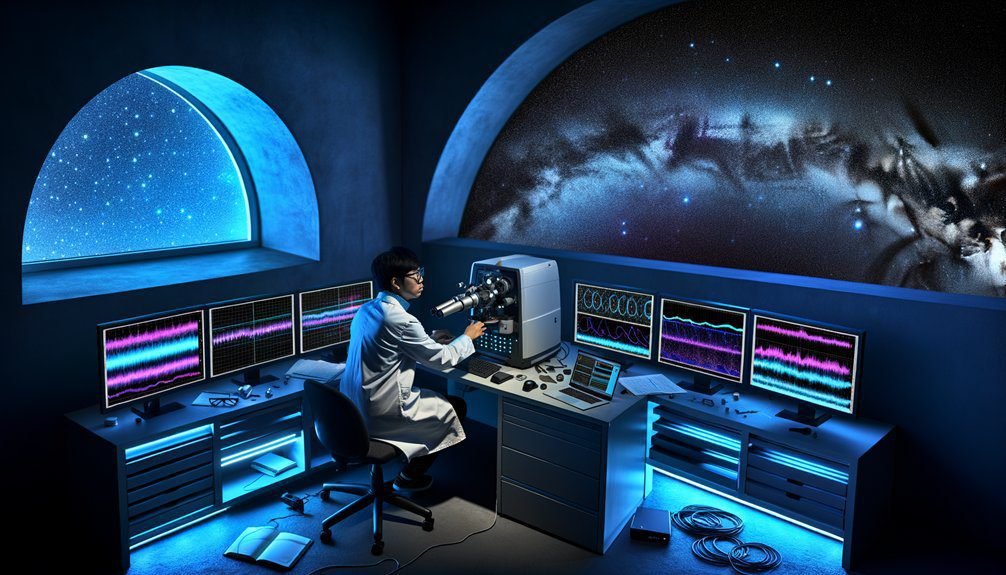
When you encounter a transit light curve that deviates from expected planetary models, you need methods that separate instrumental artifacts, stellar variability, and genuine anomalous signals with quantified confidence; this section outlines statistical frameworks, signal-processing techniques, and validation pipelines designed to do exactly that. You’ll first apply signal processing techniques—wavelet denoising, matched filters, and robust detrending—to isolate candidate features without overfitting stellar noise. Next, anomaly classification methods categorize events by morphology and repeatability, assigning likelihoods tied to observational context. Validation pipelines then cross-check with independent instruments, injection-recovery tests, and Bayesian model comparison to quantify false-alarm rates. This workflow emphasizes reproducibility: every flagged anomaly carries provenance, metric thresholds, and uncertainty budgets. Use the table below to map diagnostic outputs to interpretations and required follow-ups.
| Diagnostic | Interpretation | Action |
|---|---|---|
| Periodicity | Likely orbital | Radial-velocity follow-up |
| Asymmetry | Possible ring/dust | Multiwavelength photometry |
| Transient | Instrumental/stellar | Repeat observation |
AI and Machine Learning Transforming Signal Classification
Having established a rigorously reproducible pipeline for isolating and validating anomalous transit features, you can now consider how AI and machine learning reshape the classification stage by automating pattern recognition and quantifying uncertainty at scale. You’ll use advanced signal processing to extract features, then train models that prioritize interpretability so you can trust classifications. The focus is on reproducible metrics: false-positive rates, calibrated probabilities, and explainable attributions that support rigorous data interpretation.
- You’ll deploy convolutional and transformer architectures to detect subtle transit morphologies.
- You’ll integrate Bayesian methods and ensemble techniques to quantify uncertainty and inform follow-up priorities.
- You’ll apply feature attribution and dimensionality-reduction tools to connect model decisions back to physical hypotheses.
This approach makes classification systematic and auditable, letting you compare algorithmic outputs across datasets, iterate on preprocessing choices, and maintain transparency while accelerating discovery.
International Collaborations and Distributed Observatories
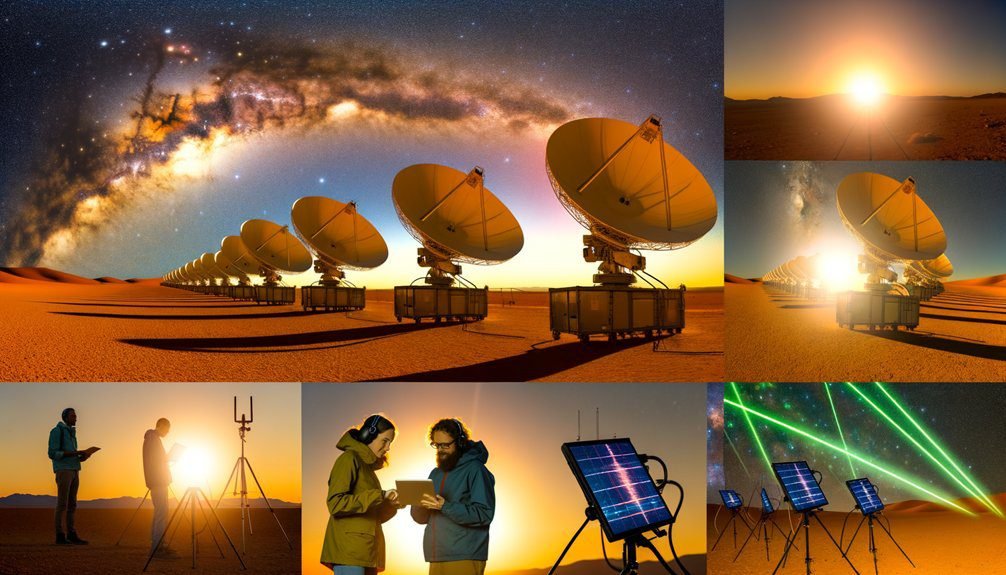
Because signals of potential technosignatures can be transient, rare, or directionally constrained, coordinated international networks and distributed observatories are essential for robust detection and verification. You’ll see that global partnerships reduce single-site biases and increase sky coverage, letting you cross-check events in real time and eliminate local interference. Distributed observatories permit differing instrument sensitivities and wavelengths, so you can characterize a candidate’s spectrum, polarization, and temporal structure more fully. Observational networks also enable standardized protocols for data formatting, time-stamping, and rapid alerting, which speeds reproducibility and peer review. When you evaluate detection claims, you’ll rely on redundancy across independent platforms and on transparent metadata to assess reliability. Funding models that pool resources and share access will be pivotal, as will governance frameworks that balance open science with security and proprietary concerns. This collaborative architecture makes your inference about extraterrestrial technosignatures more rigorous and less prone to artefacts or anthropogenic confusion.
Reanalysis of Archival Data Reveals Hidden Candidates
You should revisit archived signals with fresh algorithms to test whether past rejections hide viable candidates. Using enhanced filters and cross-correlation you’ll often recover faint features that were previously masked by noise or processing assumptions. These reexaminations can yield new candidate detections that warrant targeted follow-up.
Archived Signals Reexamined
While archival radio and optical datasets were long considered exhausted, reanalysis with modern algorithms has uncovered signals that were previously masked by noise or dismissed as artifacts. You’ll see how careful handling of signal degradation and rigorous data preservation practices let you extract patterns once invisible. You’ll want clear criteria for reexamining files, balancing curiosity with statistical rigor.
- Reprocessing: apply updated filters to reduce instrument-specific artifacts and recover buried spectral features.
- Validation: cross-check candidates across epochs and instruments to rule out terrestrial interference and calibration errors.
- Metadata: preserve calibration logs and processing histories so future teams can reproduce your steps and reassess assumptions.
You’ll approach archived signals methodically, documenting uncertainty and prioritizing reproducibility over sensational claims.
New Candidate Detections
As reanalysis tools peel back layers of noise and instrumental bias, a modest but notable set of candidate signals has emerged from archival radio and optical datasets, each warranting systematic vetting; you’ll want to treat these candidates as provisional discoveries that demand cross-epoch confirmation, independent-instrument verification, and transparent processing histories before any astrophysical claim is considered. You’ll apply new detection techniques—matched filtering, machine-learning classifiers retrained on realistic nulls, and coherent stacking across epochs—to isolate persistent features from artifacts. For each candidate, you’ll document candidate verification methods: reproducibility tests, injection-recovery experiments, and hardware-status logs review. You should prioritize candidates with clear astrophysical signatures, low false-positive likelihood, and available follow-up pathways, ensuring results remain reproducible and interpretable.
Lab-Based Simulations of Detectable Extraterrestrial Technologies
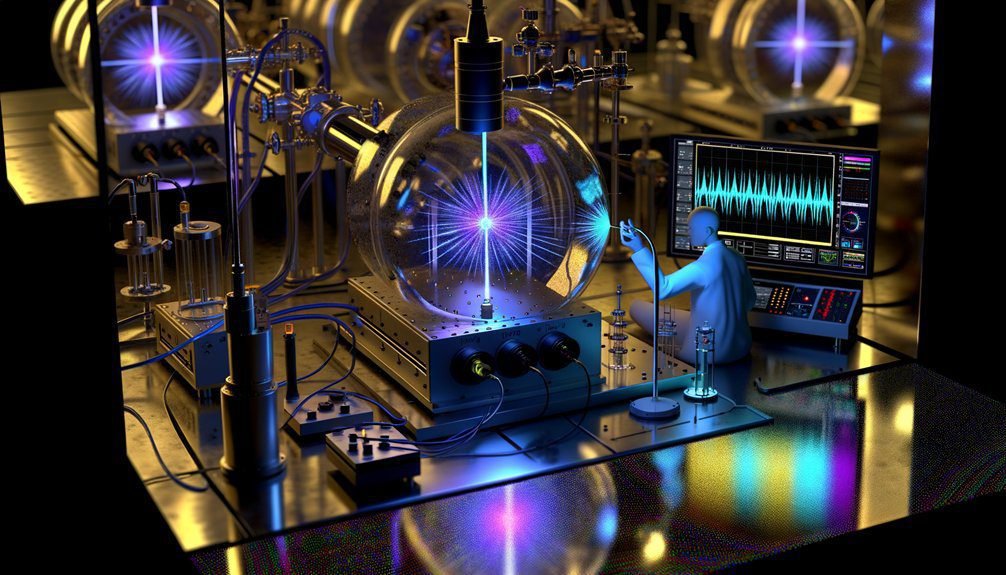
Laboratory simulations let you recreate and measure the physical signatures that hypothetical extraterrestrial technologies would produce, enabling controlled tests of detectability, instrument response, and false-positive rates. You’ll use lab environments to constrain variables, run technology simulations, and compare extraterrestrial models against known physics. That lets you refine detection methods and prioritize observables.
Laboratory simulations recreate and measure hypothetical technosignatures, testing detectability, instrument response, and false-positive rates.
- Design reproducible experiments that mimic candidate signals and instrument noise.
- Calibrate sensors with scaled extraterrestrial models to quantify sensitivity and limits.
- Run blind analyses to estimate false-positive and false-negative rates.
You’ll analyze results quantitatively, using signal-to-noise metrics, spectral templates, and statistical hypothesis testing. The approach forces explicit assumptions—power scales, materials, emission mechanisms—so you can test robustness across plausible parameter spaces. Because you control inputs, you’ll identify instrument biases and improve data pipelines before deploying telescopes. In short, lab-based simulations give you a rigorous, iterative framework to translate speculative technosignatures into measurable, testable detection strategies.
Policy, Ethics, and Protocols for Confirmed Contact
If humanity confirms contact with an extraterrestrial intelligence, you’ll need clear, pre-agreed policies and ethical frameworks that balance scientific openness, public safety, and respect for potential nonhuman agency. You’ll want policy frameworks that specify who decides, how data’s shared, and what limits protect both parties. Ethical considerations should address informed consent analogues, non-exploitation, and cultural humility. Contact protocols need tiers: detection, verification, containment, and communication, each with accountable roles. International guidelines must harmonize national laws, scientific norms, and public communication to avoid misinformation or unilateral action.
| Stage | Responsibility | Key Action |
|---|---|---|
| Detection | Observatories, analysts | Verify signal/source |
| Verification | International panel | Cross-check and confirm |
| Containment | Security, bioethics | Protect public, preserve evidence |
| Communication | Diplomats, scientists | Coordinate messages, transparency |
You’ll prefer procedures that are transparent, reversible, and reviewed, so policy frameworks, ethical considerations, contact protocols, and international guidelines remain adaptive and evidence-driven.
Frequently Asked Questions
Could Extraterrestrial Microbes Affect Earth’s Biosphere if Detected?
Yes — if extraterrestrial microbes reached Earth, they could affect life. Like a single drop creating ripples in a pond, even subtle microbial impact might alter biosphere stability through competition, gene transfer, or novel biochemistry. You’d assess risk via containment, genomic study, and ecological modeling. You’d weigh probabilities rigorously, monitoring for pathogenicity or metabolic disruption, and you’d prioritize cautious, evidence-driven steps to protect ecosystems and public health.
How Would Private Companies Profit From Confirming Extraterrestrial Intelligence?
You’d profit by commercializing access, licensing tech, and selling data to governments and firms — commercial space firms could build infrastructure, security, and communication services. You’d monetize proprietary analyses, patents, and exclusive media rights. Alien tourism could become a luxury sector: curated experiences, orbital observatories, and themed hospitality. You’d also create defense contracts, educational products, and entertainment franchises, all driven by exclusive claims, scalability, and strategic partnerships across public and private sectors.
Will Contact Change Everyday Religious Practices Globally?
Yes — contact would likely alter everyday religious practices, but unevenly. You’d see rapid faith adaptation as communities incorporate alien theology into rituals, reinterpret scriptures, or double down on existing beliefs. Some individuals would adjust prayers, symbols, and calendars; others would resist. Overall, changes would be pragmatic and gradual, shaped by institutional responses, local culture, and perceived moral implications. You’d watch theology and practice negotiate new cosmological facts.
Could Extraterrestrial Technology Be Reverse-Engineered Safely?
Yes — you could potentially reverse-engineer alien technology, but it’d be risky. You’d need rigorous safety protocols, multidisciplinary teams, and staged testing to limit contamination, unexpected energy releases, or cascading system failures. You’d be cautious, documenting unknown materials, control systems, and emergent behaviors before replication. Ethical review and global coordination would guard against weaponization or ecological harm. With patient, analytical work, you’d maximize learning while minimizing catastrophic surprises.
What Rights Would Discovered Extraterrestrial Artifacts Have Under Law?
You’d likely treat extraterrestrial artifacts as state-controlled property subject to international law — “possession is nine-tenths of the law” — so artifact ownership would hinge on discovery, custody, and treaties. Legal jurisdiction would be contested among discoverer states, international bodies, and possibly a UN framework; you’d need clear chain-of-custody, scientific access rights, and preservation mandates. Courts and diplomats would balance sovereignty, common heritage principles, and planetary protection obligations.